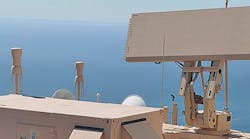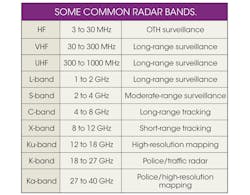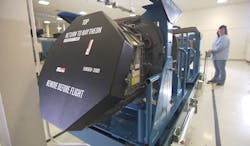The purpose of radar is to provide some form of warning, whether as part of a military surveillance system, a weather-tracking system, or our efforts to better know the universe. Short for radio detection and ranging, radar was initially developed for military use (to detect ships and aircraft during World War II), but now has many applications. Radar systems have matured with the development of different technologies, such as RF/microwave amplification and digital signal processing (DSP). They are now used on earth, at sea, on the road, and even in outer space.
Radar can operate with continuous-wave (CW) signals. More commonly, though, it transmits and receives pulses, measuring the range or distance to a target based on the delay time of the pulses and the velocity of the target based on the Doppler frequency shift of the received signals. A great deal can be learned about the target by analyzing the radar return signals, including the size of the target (based on the magnitude of the returned signals) and any moving parts on a target (based on modulation of the radar returns). Radar systems can be configured in a number of different ways and across many different frequency bands (see table).
In a bistatic radar system, the radar’s transmit and receive antennas are at different locations relative to the target, such as a ground-based transmitter and an airborne receiver. In a monostatic radar system, the transmitter and receiver are in the same location. In a quasi-monostatic radar system, the transmit and receive antennas are slightly separated but still appear to be in the same location as viewed by the target. As with many systems and technologies, the cost increases with the number of functions provided.
For many, radar technology signifies a physically imposing system (Fig. 1), either looming from the edge of a desert or humming within the nose of a fighter aircraft. Domestic companies providing such technology also tend to be large, including such names as BAE Systems, ITT Exelis, Lockheed Martin, Northrop Grumman, Raytheon Co., and Telephonics. Raytheon, for example, supplies radar systems for the ground, at sea, and in the air, employing a variety of technologies and approaches. The firm’s active electronically scanned array (AESA) radar systems have been used throughout the world, by different fighting forces, to provide early warning for fighter jet pilots
The APG-63(V)3 AESA radar (Fig. 2) is an adaptable, all-weather system that has been installed in a large number of F-15 fighter jets throughout the world, evolving into a multimode electronic system capable of numerous radar-based functions. AESA radar systems employ electronic (rather than mechanic) beam steering, with the capability of detecting targets in multiple directions and tracking both air and surface targets at the same time. Raytheon’s engineers have enhanced their AESA radar systems over the years by means of a modular design approach, using replaceable function boards to simplify service and repair (Fig. 3).
More recent radar systems, such as the AN/TPS-78 S-band long-range radar developed by Northrop Grumman, leverage solid-state device technology for high-power signal generation. The firm’s AN/TPS-78 system as well as the TPS-703 radar system used a stacked-beam approach to illuminate and detect targets, and can simultaneously detect low- and high-altitude targets even with a great deal of clutter. Both systems are used in numerous applications, including for air traffic control (ATC) and air-defense systems. Both feature a “wartime” mode in which they can operate their beams with frequency agility to prevent interference from jammers.
Driving Growth
In spite of their traditional association with military applications, radar systems are steadily finding their ways into commercial applications. Even though collision-avoidance radar systems operate at millimeter-wave frequencies at 77 GHz, an increasing number of integrated-circuit (IC) suppliers are finding ways to design and fabricate practical 77-GHz radar transceivers for this fast-growing application. A number of different frequency bands have been explored for this use of radar, including at 24 GHz. Some of the world’s leading suppliers of ICs are developing transceiver chipsets, including Analog Devices, Freescale Semiconductor, Infineon Technologies, and TriQuint Semiconductor.
These devices support a number of different grades of vehicular collision-avoidance radar systems, including for unmanned ground vehicle (UGV) systems. Some of these collision-avoidance systems incorporate frequency-modulated-continuous-wave (FMCW) technology, with velocity of a target measured by distance over time. Others use pulsed Doppler techniques, with velocity and distance to a target measured instantaneously.
Automotive radar is a market and technology that is experiencing a great deal of development, as these systems expand from just high-end automobiles to lower-priced vehicles as the radar electronics becomes more affordable. Because of the lack of established standards for the technology, it is not yet a commodity application, but is available in a number of different formats; these include narrowband and ultrawideband (UWB) systems. In addition, radar system (and automotive) manufacturers are not always familiar with the component-level specifications and how they relate to radar systems. This communication must improve for automotive radar systems to become more widely spread.
Current automotive radar systems include the electronically scanned radar (ESR) system from Delphi, a multimode system that provides wide coverage at midrange distances and high resolution at long distances using a single radar beam. This type of coverage and its associated processing can identify both vehicles and pedestrians across the width of the equipped vehicle and can detect as many as 64 targets in the path of an equipped vehicle. The data from the ESR system can be applied to a number of functions, including adaptive cruise control and forward collision-warning capability. Delphi’s 77-GHz ESR system is powered by a number of gallium-arsenide (GaAs) ICs from TriQuint Semiconductor.
Freescale has been active in the development of chipsets for Advanced-Driver-Assistance-Systems (ADAS) applications, including for implementation and control of the 77-GHz collision-avoidance radar system and the front- and rear-view cameras in each vehicle. The 77-GHz radar chips support a number of applications, including adaptive cruise control (ACC), blind-spot detection (BSD), emergency braking, forward-collision warning (FCW), and rear-collision protection (RCP). For reliability and safety, its semiconductor solutions are based on system-in-package (SiP) technology. These use widely accepted communications protocols—such as PS15 and DSI—for interaction with other vehicular electronic systems, like the airbag systems.
Weather Warnings
In addition to making traffic safer, commercial radar systems are also helping to predict coming weather patterns and track storm systems. Weather radar systems use radar returns to help determine the intensity and relative speed of a storm system. These radar systems typically operate at a wavelength of 10 cm, which is a frequency of about 3000 MHz, using very short pulses at about 1000 pulses/s. Weather radar systems employ one of two scanning techniques. In the plan-position-indication (PPI) approach, the radar holds its elevation angle constant but varies its azimuth angle. A 360-deg. scan is called a surveillance scan, while a scan of less than 360 deg. is a sector scan.
In the range-height-indication (RHI) approach, the radar holds its azimuth angle constant but varies the elevation angle. The elevation angle is typically rotated from the horizon to the zenith, or a point in the sky directly overhead. A Weather Service radar usually requires a series of surveillance scans at increasing elevation angles to collect adequate data for analysis.
The Next Generation Weather Radar, NEXRAD, can detect air motion through the use of Doppler measurements and analysis. Hundreds of NEXRAD sites have been constructed across the United States to aid with weather analysis and predictions, since the systems have the capability to detect cold fronts and thunderstorm fronts.
One of the more intriguing uses of radar technology has been for planetary exploration. Using either an Earth- or space-based radar antenna and system, a narrow beam is transmitted into space to illuminate a distant target. Doppler measurements can provide information about the relative speed of the target, whether a planet, comet, asteroid, or even a wayward satellite. Such planetary radar was first applied in 1946 when a radar system illuminated the moon and provided some insight into its sand-like structures. In many ways, radar technology is only beginning, with many more applications still to be found for this particular use of EM energy.




